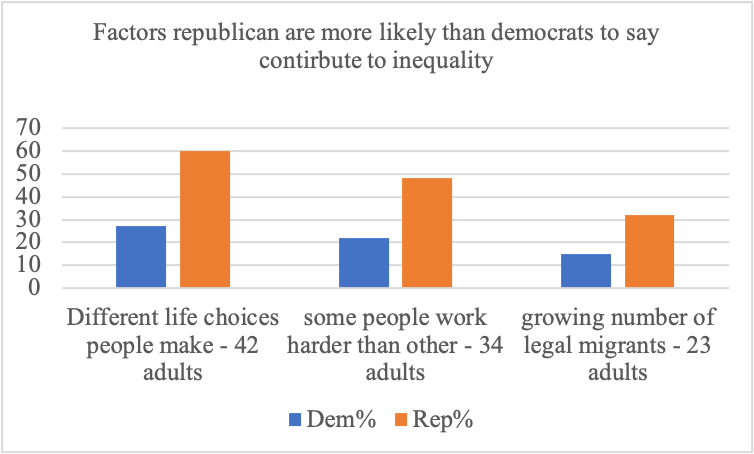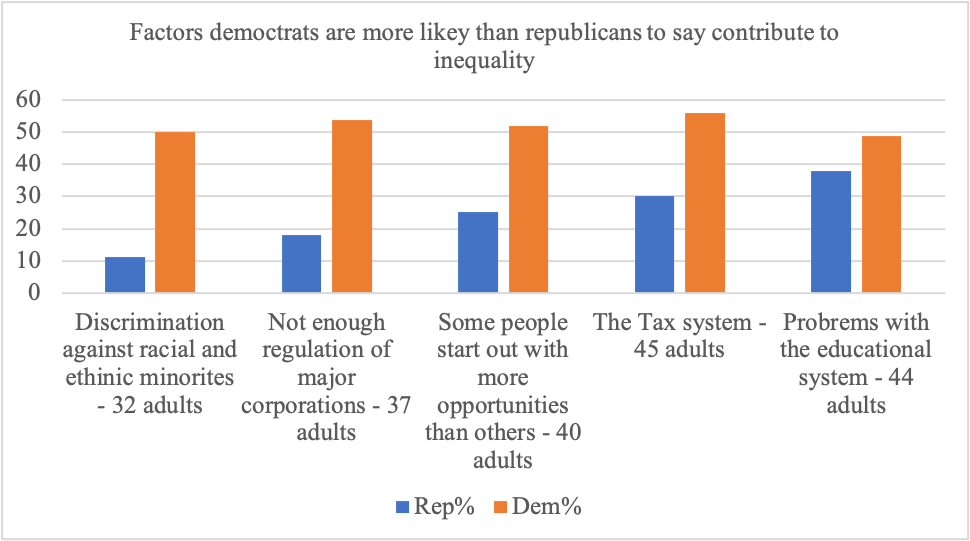This policy brief mainly focuses on how the modern political parties and new US government elections led to Inequality in wealth and status in society. It explains how the two main American parties led to voting constraints, restrictions, and racial disparities in the American states. It also explains how American political parties gained power and became popular in the Northern and Southern parts. The forces of the party depended on the support it got from the voters and how it will bring change and curb some problems among the whites.
Political parties and elections have different historical backgrounds in each country and state. Parties’ primary purpose is to assist an aspirant in cliquing power or winning a political competition. According to (McClelland 2010), political parties began before the 18th century, and people came together to advocate for their shared interests. (McClelland 2010) continues to argue that by the end of the 18th century, modern political parties started to form as the first party began in modern Britain and America. The main aim of the political parties was to create a robust government compared to other states and countries. Since people wanted to fight and defend their countries during the war, the best way was to create a strong party that would unite people to fight their enemies. Still, in return, leaders had a hidden agenda of gaining more power and getting rich, which led to wealth inequality. Modern political parties’ development extended to other countries that emerged during the fight for independence. Thirsty for power and wealth among the nations led to voters remaining poor since they had no access to quality health, low-level education, poor transport, lack of business opportunities and jobs for the ordinary citizen, lack of security, and many other problems caused by parties and elections. In this policy brief, I will discuss how the Republican and Democratic parties in America led to wealth inequalities and how they caused differences in status and power.
In America, the two main parties dominated the region; there were Whigs, who were mainly against slavery, and Democrats, which was supporting slavery. An intense debate arose between the parties on whether the new states should allow slavery. The Democratic Party strongly supported pro-slavery in South America. Still, on the other hand, the Whigs were not supporting the issue of slavery since it would have a strong political influence in the states. Slavery threatened the whites since if slavery continued, there would be a solid political status for the blacks In America compared to the whites. Having many blacks in America resulted in power being shared between the blacks and white since they had equal voting power in the different regions. Since the members of the Whigs could not agree on the issue of slavery, it ended up collapsing. After the Whigs party collapsed, it formed a new party called the Republican Party, which could fight the expansion of slavery. The Republican Party later became more potent in 1860 in North America.
Since the Republicans had become more powerful due to their anti-slavery campaign, they named Lincoln their presidential party leader and won the presidency during that time. Lincoln, who had promised that he would not interfere with slavery in states, and his party were too anti-slavery after winning the election to the extent that the South could not tolerate that. The hot debate on anti-slavery ensued, which led to the abolition of slavery nationwide. After the war of anti-slavery in the late 1800s, Republicans began to fight for the formerly enslaved people in the South to have their rights. In 1866, the party passed rights saying that blacks have the same rights as whites to vote. However, during the civil war fighting for the rights of black men, the government spending made the northern business people rich, which enabled the white republicans to lead in wealth and power since they became industrious. Later the Republicans thought that fighting for black rights in a white country was not a good idea to keep them in control. They focused on industrialization and left the idea of anti-slavery on its device, which led to the difference in wealth and power status in the region.
In the 21st century, America went through a demographic shift, as there was high immigration, both legal and illegal. It led to democratic and business elites reforming the immigration laws to give over 10 million illegal immigrants legal status and the right to vote like any other citizen. However, Republicans had strict policies on immigration, which became popular, leading Mitt Romney to lose the presidential bid in 2012 as over 71% of Hispanic voters supported Barrack Obama. Winning of election tells us how one can become more powerful by showing support to the high number of most vulnerable voters in a region. Since both Hispanics and blacks became more popular in America, they supported the leader who showed support to them.
They argue that only 44% of all white voters cast their votes for democrats as of the 2020 presidential election since there is no object to being a part of the increasingly diverse population amalgam that is likely to develop over the coming decades gradually. Alba tells us that there are intermarriages between the whites and other Americans who immigrated, and this is changing slowly by slowly for the republican status of power and wealth.
In conclusion, wealthy people will continue to be rich and powerful. They will remain more potent since the candidates and political parties only change their strategy to convince the voters to vote for them to stay in power. Leaders have access to high-quality health care, and their close friends and relatives continue getting high-level education and security compared to ordinary citizens. According to William Domhoff, the main agenda for Republicans was to stop slavery and immigration for the whites to have more power and control American wealth. Republicans thought more votes from immigrants would change their status. In the 21st century, political leaders are greedy to extend the leadership circle, especially in developing countries. Access to high-quality life remains in their lineage or close friends and families. The poor will remain poor for many decades if they do not change their mentality toward the power they have in voting. An election is an urgent problem that people should speak out about to change the purpose of political parties. (G William Domhoff) argues that the result is that the electoral process focuses on a candidate-selection process, with minimal emphasis on offering policy alternatives to the voting public.
Parties and Elections Fact sheet
The Fact sheet shows the contrasts of strengths and weaknesses of both the democrats and republicans parties that have in America. After the long history of how the Americans came up with two main parties that have dominated politics since the 18th century, it has led to wealth inequality and power in the region. The issue is now the main agenda for both parties during the campaigning since parties address differently to the voters. According to Horowitz 2020 Democrats and Republicans differ on whether addressing economic Inequality requires significant changes to the economic changes. He continues to argue that republicans led to financial and wealth Inequality in America since they were against the slave trade for the whites to remain in control of power. The charts below were research done by Horowitz, J. M., Igielnik, R., & Kochhar, R. (2020). They show the factors that Republicans and democrats say contribute to wealth inequality.
Chart 1.

Chart 1 shows the number of adults who participated in the survey and the percentage of the participants who felt the factors led to wealth imbalance. Horowitz, J. M., Igielnik, R., & Kochhar, R. (2020) researched American voters belonging to different parties to give their say on factors that led to Inequality. The chart shows that more republicans felt that other life choices, some people working harder and a growing number of immigrants led to wealth inequality in American society. The last factor was the increasing number of immigrants, which was the main aim of the formation of the Republican Party to stop the slave trade and immigration, which was a threat to voting power and wealth imbalance among the whites.
Chart 2.

Chart 2 was also a survey done by Horowitz, J. M., Igielnik, R., & Kochhar, R. (2020). It shows five factors, which more democrats say, led to Inequality in America. The first factor is discrimination against racial and ethnic minorities. Thirty-two adults were surveyed, and 50% of those adults were democrats who said discrimination led to Inequality compared to 11% of republicans. All the factors outlined in both charts were because of parties and elections.
Policy Brief References
Alba, R., & Maggio, C. (2022). Demographic change and assimilation in the early 21st-century United States. Proceedings of the National Academy of Sciences, 119(13), e2118678119.https://www.pnas.org/doi/abs/10.1073/pnas.2118678119
B. (2017). The Party of Lincoln is now the Party of Trump. New York Times.http://gsood.com/research/press/InOut_NYT.pdf
Domhoff, G. W. (1968). Who Rules America? Science and Society, 32(3).https://philpapers.org/rec/DOMWRA
Domhoff, G. W. (2021). Who Rules America? The Corporate Rich, White Nationalist Republicans, and Inclusionary Democrats in the 2020s.Routledge.https://www.taylorfrancis.com/books/mono/10.4324/9781003231400/rules-america William-Domhoff
Drutman, L. (2020). Breaking the two-party doom loop: The case for multiparty democracy in America. Oxford University Press USA.https://books.google.com/books?hl=en&lr=&id=_FO_DwAAQBAJ&oi=fnd&pg=P P1&dq=How+to+break+the+twoparty+hold+on+American+politics&ots=26F2iYMGiX&sig=sdzYu1YFKWkYfHRmmksNrUqHC1Q
McClelland, J. S. (2010). The Crowd and the Mob (Routledge Revivals): From Plato to Canetti. Routledge.https://www.taylorfrancis.com/books/mono/10.4324/9780203835531/crowd- mob- Routledge-revivals-McClelland
Fact check references
Franko, W. W., & Witko, C. (2018). The new economic populism: How states respond to economic Inequality. Oxford University Press.https://books.google.com/books?hl=en&lr=&id=YJc4DwAAQBAJ&oi=fnd&pg=PP1&dq=how+elections+in+america+led+to+wealth+inequality&ots=odXJtNSNhP&sig=J1pez2I46MpikhmUfTZxNONucVY
Hacker, J. S., & Pierson, P. (2018). Winner-take-all politics: Public policy, political organization, and the rise of top incomes in the United States. In Inequality in the 21st Century (pp. 58-68). Routledge.https://www.taylorfrancis.com/chapters/edit/10.4324/9780429499821-12/winner-take-politics-public-policy-political-organization-precipitous-rise-top-incomes-united-states-jacob-hacker-paul-pierson
Horowitz, J. M., Igielnik, R., & Kochhar, R. (2020). Most Americans say there is economic Inequality in the US, but fewer than half call it a top priority. Pew Research Center, 1-51.https://www.courthousenews.com/wp-content/uploads/2020/01/pew-inequailty.pdf
Norrlof, C. (2018). Hegemony and Inequality: Trump and the liberal playbook. International Affairs, 94(1), 63-88.https://academic.oup.com/ia/article-abstract/94/1/63/4762707
SHEETS, D. Economic Inequality And the 2020 Campaign.https://www.chausa.org/docs/default-source/health-progress/economic-inequality-and-the-2020-campaign.pdf?sfvrsn=0
Trump, D. Economic Inequality and the 2020 Campaign March-April 2020.https://www.chausa.org/publications/health-progress/archives/issues/march-april-2020/economic-inequality-and-the-2020-campaign
 write
write